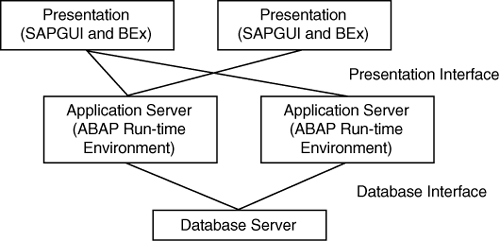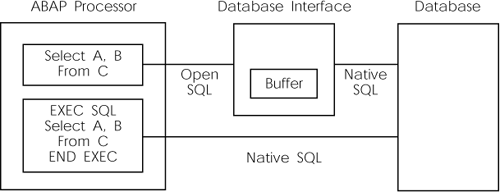Section B.1. SAP Basis 3-Tier Architecture
B 1 SAP Basis 3 Tier Architecture
The SAP Basis 3-tier architecture consists of presentation front ends, application servers, and a database server, as shown in Figure B.1.
Figure B.1. SAP BASIS 3-TIER ARCHITECTURE

B.1.1 Presentation Interface
The SAPGUI interacts with an application server using an SAP presentation protocol, where generic GUI descriptions, instead of prepared screen images, are exchanged. This interaction results in a compact data stream, consisting of 1 to 2 kilobytes of data. Thus, the interface through WAN can be easily achieved without performance problems.
BEx communicates with an application server through the SAPGUI.
B.1.2 Application Server
SAP applications are written in ABAP or ABAP/4 (Advanced Business Application Programming, a fourth-generation language). ABAP runs on application servers. ABAP programs and flow logic for each screen are processed interpretatively by the R/3 run-time environment. The ABAP run-time environment is written in C and C++.
We used ABAP when writing transfer rules and update rules earlier in this book.
B.1.3 Database Interface
A remote SQL protocol is used for data transfer. The buffer, as shown in Figure B.2, stores often-used data. Changes to buffer contents are transmitted immediately to the database and broadcast at short time intervals by a message service to all other application servers.
Figure B.2. DATABASE INTERFACE

We will discuss the message service later in this section.
B.1.4 Open SQL
ABAP programs written in Open SQL are portable across different database systems. Along the way, the buffer mechanism enhances performance. Open SQL doesn't support the relational join operation. Instead, you can use views in ABAP. The database interface checks and converts Open SQL statements into Native SQL statements; it also detects syntax errors before run time.
B.1.5 Native SQL
Although programs written in Native SQL are not portable, all features of the database, including proprietary expansions of the standard SQL, are available for use. Obviously, Native SQL supports the relational join operation, but the DBMS cannot recognize an error in Native SQL until run time.
BW uses more Native SQL than R/3 does. For example, when the database is Oracle, BW uses many Oracle proprietary features designed for data warehousing. These features may not be available in other DBMSs.
Part I. Guided Tours
Business Scenario and SAP BW
- Business Scenario and SAP BW
- Sales Analysis A Business Scenario
- Basic Concept of Data Warehousing
- BW An SAP Data Warehousing Solution
- Summary
Creating an InfoCube
- Creating an InfoCube
- Creating an InfoArea
- Creating InfoObject Catalogs
- Creating InfoObjects Characteristics
- Creating InfoObjects Key Figures
- Creating an InfoCube
- Summary
Loading Data into the InfoCube
- Loading Data into the InfoCube
- Creating a Source System
- Creating an Application Component
- Creating an InfoSource for Characteristic Data
- Creating InfoPackages to Load Characteristic Data
- Checking Loaded Characteristic Data
- Entering the Master Data, Text, and Hierarchy Manually
- Creating an InfoSource for Transaction Data
- Creating Update Rules for the InfoCube
- Create an InfoPackage to Load Transaction Data
- Summary
Checking Data Quality
- Checking Data Quality
- Checking InfoCube Contents
- Using BW Monitor
- Using the Persistent Staging Area (PSA)
- Summary
Creating Queries and Workbooks
- Creating Queries and Workbooks
- Creating a Query Using BEx Analyzer
- Organizing Workbooks Using BEx Browser
- Using a Variable to Access a Hierarchy Node Directly
- Summary
Managing User Authorization
- Managing User Authorization
- Creating an Authorization Profile Using Profile Generator
- Creating an Authorization Object to Control User Access to the InfoCube Data
- Integrating Profile Generator and BEx Browser
- Summary
Part II. Advanced Topics
InfoCube Design
- InfoCube Design
- BW Star Schema
- InfoCube Design Alternative I Time-Dependent Navigational Attributes
- InfoCube Design Alternative II-Dimension Characteristics
- InfoCube Design Alternative III Time-Dependent Entire Hierarchies
- Other InfoCube Design Techniques
- Summary
Aggregates and Multi-Cubes
Operational Data Store (ODS)
- Operational Data Store (ODS)
- Creating an ODS Object
- Preparing to Load Data into the ODS Object, Then into an InfoCube
- Loading Data into the ODS Object
- Loading Data into the InfoCube
- Using 0RECORDMODE for Delta Load
- Summary
Business Content
- Business Content
- Creating an R/3 Source System
- Transferring R/3 Global Settings
- Replicating R/3 DataSources
- Installing Business Content Objects and Loading R/3 Data
- Summary
Generic R/3 Data Extraction
- Generic R/3 Data Extraction
- Creating Views in R/3
- Creating DataSources in R/3 and Replicating Them to BW
- Creating a Characteristic in BW
- Loading Data from R/3 into BW
- Summary
Data Maintenance
Performance Tuning
- Performance Tuning
- BW Statistics
- System Administration Assistant
- Tuning Query Performance
- Tuning Load Performance
- Summary
Object Transport
Appendix A. BW Implementation Methodology
Object Transport
Appendix B. SAP Basis Overview
Object Transport
- Object Transport
- Section B.1. SAP Basis 3-Tier Architecture
- Section B.2. Dispatcher, Work Processes, and Services
- Section B.3. Memory Management
Appendix C. Glossary
Appendix D. Bibliography
EAN: N/A
Pages: 106
